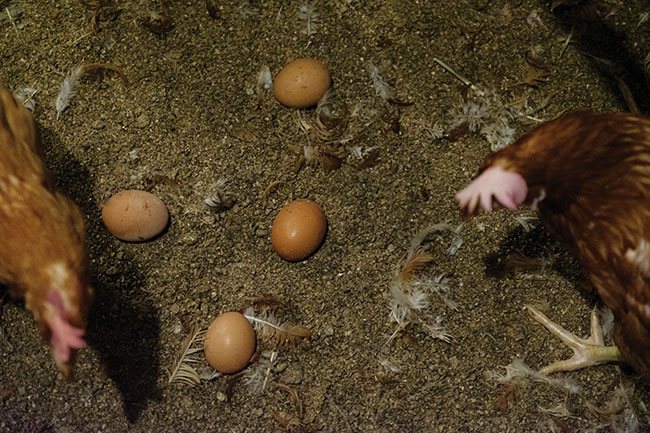
On Aviaries Column: Fighting floor eggs
By Erika Prewitt
Features LayersThree tips for combating the issue in cage-free layer housing.
 Litter should be dry with a consistency of coffee grounds to avoid floor eggs.
PHOTO CREDIT: Big Dutchman
Litter should be dry with a consistency of coffee grounds to avoid floor eggs.
PHOTO CREDIT: Big Dutchman Producers commonly ask about floor eggs when discussing cage-free management. Ideally, they should be under two per cent for your flock. If floor eggs are over this mark, it’s time to take steps to improve this number.
Keeping records and having information on this topic is crucial.
Have a clipboard at the front or back of the house so that workers can record when and how many floor eggs they picked up from each aisle.
Knowing when and where floor eggs are laid is one of the first steps to tackling this issue. It also lets you know if a certain aisle is more problematic than another. High percentages of floor eggs can result from the need for workers to walk the aisles more often, litter aisle conditions and lighting.
1. Walk the aisles often
The first question to ask is are the floor eggs being laid before workers are present in the house?
It is important to have walkers in the house as soon as lights come on. Laying on the floor can be enticing to a hen if she is undisturbed.
Having walkers available as soon as lights come on to walk the flock prevents the birds from getting comfortable in the litter aisle. When hens and their laid eggs remain undisturbed, this can seem like an attractive place for others to lay as well.
The issue very quickly has a snowball effect. One egg can quickly become 10 when the eggs are left on the floor. This issue will continue to worsen each day that eggs are not immediately picked up.
2. Maintain litter aisle conditions
Second, evaluate the condition of the litter aisle that they are laying in. Often, floor eggs are higher in outside rows with a solid wall on one side. They also favour partition and aisle doors. Oftentimes, this is the first place that you start seeing floor eggs.
If these areas continue to be a floor egg hotspot flock after flock, you might want to consider training wire. If you have ramps or bridges of any kind in the aisle, don’t place them next to doors – this makes it even more attractive to hens.
Litter depth can also be a culprit for floor eggs. Litter should be dry with a consistency of coffee grounds and no higher than two to three inches.
Litter is important for birds to exhibit their natural behaviours such as dust bathing, but too much of it makes laying eggs there too enticing for your hens.
Barn workers will need to remove excessive litter either manually or with a litter reduction system. If hens have access underneath the system and the house is equipped with a litter reduction system, utilize it during the morning within the laying period. This not only helps to eliminate excess litter but also helps disturb the hens so that they don’t find this area to be somewhere where they can lay uninterrupted.
3. Proper lighting
Finally, the third condition producers should examine is the house lighting. Again, if hens can access underneath the system, make sure the lighting under there is at 100 per cent intensity.
Areas that mimic the condition of a nest by being dark, remote and a place they are undisturbed will seem attractive to them to lay.
Look to make sure the overall aisle lighting isn’t too dark or, vice versa, that your system lighting isn’t too bright, pushing them to find somewhere else to lay.
Hens will usually choose the nest area to lay if it is secluded, dark and contains a nest material that they approve.
Also, make sure the quantity of nests is appropriate for the population of the house. When one of these areas lack, the floor can be an alternative laying area.
Print this page